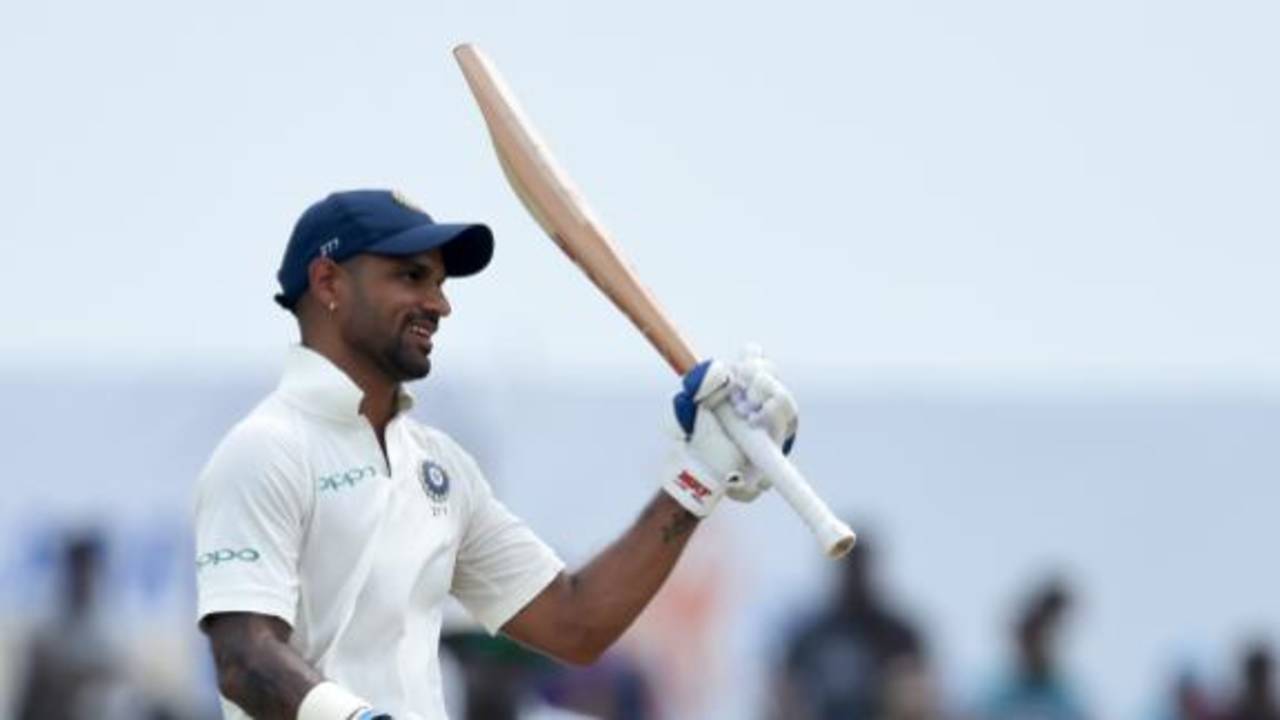Fortunate Dhawan directs his sail
A player making a comeback could easily have been content with hundred more routine than 190 off 168 balls, but that's where Shikhar Dhawan did more
Sidharth Monga in Galle
26-Jul-2017
Test openers share a special bond. They walk out together for one of the most difficult tasks in cricket: negotiate the mischievous new ball, two men against 11. They know each other's weaknesses and insecurities. They thrive off each other's strengths. When KL Rahul, a nervous wreck, failed on his debut in Australia, the two other openers in the squad, M Vijay and Shikhar Dhawan, comforted him.
Dhawan may have had mixed feelings then that his comeback into Test cricket would not have been possible without bad fortune for both his brothers in arms: Vijay and Rahul. For if Vijay had recovered well enough after his wrist surgery, or if Rahul had not taken ill, Dhawan would have struggled to find a place in the XI in Galle. Not too long ago, India brought in Dinesh Karthik into the XI ahead of Rishabh Pant because Karthik had been in the squad before him. By that logic, Abhinav Mukund would have made it if only one of the two first-choice openers had been unavailable.
Then, some days life just feels beautiful. You find yourself playing Test cricket in Galle, by the sea and the fort; 10 days ago you might have been wondering what to do in rainy Delhi or cold Melbourne. The pitches in Galle can be spiteful, the hosts tend to find their magic here, but you walk out to a benign track. Your captain then wins the toss for the first time in seven attempts. And just in case you have any doubts over whose day it is, they drop you on 31. That play also injures the opposition's third spinner, reducing them to 10 men.
"My plans were to go to Melbourne and spend time with my family, do training and get fit for the one-day series," Dhawan said of what he was thinking 10 days ago, before he replaced an injured Vijay in the squad. "I was in Hong Kong actually on holiday and from there I flew back to India and joined the team. I think destiny had a different plan for me."
In cricket, especially when batting regularly against the red new ball, you deal with failure more than success. You can't grudge a player this run of fortune once in a while. And almost everybody gets such a day of fortune over time, but it is more about what you do with this fortune. A player making a comeback into the side could easily have been content with hundred more routine than 190 off 168 balls, but that's where Dhawan did more.
Dhawan made India's statement boldly and conspicuously in the first exchange. The fourth ball of spin he faced, he was outside his crease, right to the pitch of the ball. Earlier he had driven it against the intended turn, along the ground, and between mid-on and midwicket. He skipped down to the seventh ball of spin he faced, driving Dilruwan Perera between mid-off and extra cover for four. The message was clear: India were looking to smash the spinners' confidence while the going was good. In his 168-ball stay, he faced 111 balls of spin; he skipped down the pitch to 28 of them - once every four balls - for 36 runs. He was in control for 26 of those forays. He enjoyed the resultant short balls sumptuously.
Then there was the sweep, not a favoured weapon of Indian batsmen but used copiously by Dhawan in this innings, on 12 occasions for 31 runs. If you step out and sweep well, you pretty much negate the spinners. Dhawan was quick to acknowledge that he was able to do so because there was little turn on the pitch. Having said that, the fact remains that on the first day of the series, the two specialist Sri Lanka spinners were made to bowl 49 wicketless overs for little under four an over. In a series of three back-to-back Tests, they all count.
Dhawan was never once beaten on the outside edge; once the ball hit his outside edge, and once the leading edge. In all, Dhawan was not in control of only nine of the 168 deliveries he faced. The other striking aspect of his innings was the singles he took off good balls, placing them wide of cover. In the first session he went at a strike rate of over 80 despite hitting only eight boundaries.
It was only in the second session that he began looking for boundaries actively, delaying the cut here, sweeping fine there. After reaching 112, he never faced two dots in a row. It might seem like mayhem, but apart from the odd hook shot, the only time he went airborne was the shot that got him out, minutes before tea.
This innings might not tell you more about the rest of Dhawan's Test career, but some days are just meant to stand by the sea with arms aloft, helmet in one hand and bat in the other, and to just take it all in: the southern hospitality, the salty breeze, the team's applause. As Dhawan himself said, he was not the man to overthink and not enjoy the moment. "One thing about me is that I don't like to be sad all the time. I like to be happy and so I was enjoying myself over there and knew that if things have to come, they will come my way," Dhawan said of the time he spent playing for Delhi after being dropped.
And when they come Dhawan's way, they do so in style.
Sidharth Monga is an assistant editor at ESPNcricinfo
